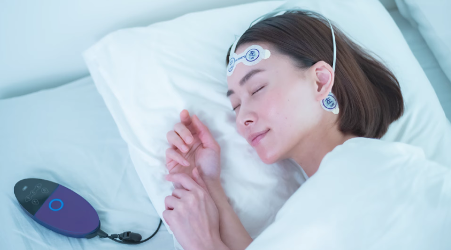S'UIMIN
Using IoT for Comfortable, Accurate Sleep Monitoring
The Opportunity
Restless Sleep Creates Health and Mental Issues
The average adult between the ages of 18 and 64 needs seven or more hours of sleep each night in order to function properly. Yet for an unfortunately large portion of the population, getting enough quality sleep remains a challenge. As sleep deficiency has been linked to such chronic health problems as depression, heart and kidney disease, obesity, and even stroke, understanding our sleeping patterns – and how to improve them – has become an opportunity for individuals and businesses to leverage IoT for needed data.
Traditionally, if one wanted to study their sleep patterns or diagnose a sleeping disorder, it required specialized monitoring in a laboratory or hospital setting. These tests can feel quite invasive, with numerous electrodes affixed to the subject’s head, as well as sensors attached to the nose, chest, abdomen, and fingertips.
Recognizing that sleeping in an unfamiliar environment with tons of devices attached to your body can put some people off of sleep testing altogether, S’UIMIN CEO and founder Masashi Yanagisawa set out to create a new sleep measurement solution that offers a simpler, more comfortable solution that works in the user’s own home.

S'UIMIN“We decided that in order to effectively evaluate sleep, it is necessary to look back on one’s perceptions while viewing objective measurement results shortly after waking up.”
The Solution
An IoT Device That Monitors Sleep Volume and Quality
That solution was InSomnograf, a service that acquires brain wave data while a patient sleeps. It utilizes a proprietary AI to analyze the aggregate information to visualize the quality of sleep. From there, the device can connect users with physicians to better manage sleep care. At the center of the service is a wearable device that incorporates small sticker-like electrodes placed on the forehead and back of the ear.
Users wear the device for between two and five days, during which the device will calculate more than 20 different sleep indicators that range from how long it takes to fall asleep to the amount of time spent in sound vs. fitful sleep. The raw brainwave data is uploaded to the cloud daily via Soracom’s cellular connectivity, where it is analyzed by AI before providing users and caregivers with comprehensive reports through the web browser of their choice.
In earlier iterations, the service would store a week’s worth of brainwave information in a loaned measurement device, then manually retrieve, analyze, and report the data from the device after it was returned. This introduced a number of inefficiencies and a time-consuming QA process that meant users couldn’t access their results for more than a week after the measurements were taken. This often made it difficult for patients to remember their sleep sensations on any particular date.
“We decided that in order to effectively evaluate sleep, it is necessary to look back on one’s perceptions while viewing objective measurement results shortly after waking up,” said Yanagisawa. “So we set out to create a specification that would allow the results to be viewed the next morning.”
Why Soracom?
A Familiar Solution with Strong Support
The solution was to install a communication module in the device that made it possible to send data directly to the cloud; to do that, the S’UIMIN team reached out to a familiar partner in Soracom. The team lead in charge of development for the InSomnagraf had used Soracom on a previous job, and Soracom’s customer-focused design and support fit the project.
“Since we were familiar with the Soracom platform and completely satisfied with the service, we decided to give it a shot,” said Yanigasawa. “The connectivity cost was low, and the Soracom team had excellent engineers as well as technical support, so we felt confident that we could rely on them if something went wrong.”
By using Soracom’s cellular connectivity service, Soracom Air, S’UIMIN is not only able to keep a fleet of InSomnografs connected, it also gives them access to management tools like the Soracom User Console. This powerful tool helps product managers monitor the status and performance of an entire fleet of connected devices, while features like Soracom Beam empower improved maintenance and lower data costs.
This improvement has allowed developers to continue iterating and improving the Insomnograf, resulting in a technology that is not only more comfortable for the patient but has a measurement accuracy that rivals the tests performed in the hospital.

The Outcome
Smart Devices Helping to Improve Quality of Life
The success of the InSomnograf has seen the test welcomed into medical centers and hospitals, where it has even been embraced as an optional test during regular checkups. S’UIMIN is looking to expand the service nationwide, along with brain docks and genetic testing. As adoption continues to grow, Yanigasawa believes the device may become even more ingrained in the medical community.
Sports organizations have also embraced the InSomnograf, with multiple soccer teams using the tool to help improve their players’ performance. The company has also begun fielding inquiries for collaborations with other organizations in the sleep aid industry, including other devices, beverages, and supplements, that hope to test the efficacy of their own solutions.
As the data continues to inform the product’s further evolution, Yuki Yamashita of the S’uimin technology development division believes they are only scratching the surface of what the InSomonograf can do.
“In the future, we would like to approach not only health check centers and manufacturers of sleep-related products but also those who are unsatisfied with their sleep, even those who aren’t yet aware of their sleep problems,” said Yamashita. “Eventually, we would like to develop a solution for improving sleep that can be widely deployed to individuals’ homes, as well as medical facilities.”
